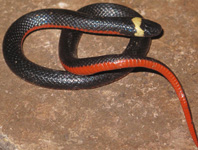Abstract
During a survey of soil nematodes in Iran, a new species of Ditylenchus Filipjev, 1936 was discovered. Ditylenchus sarvarae sp. n. is characterised by its body length (1.0–1.4 mm), lateral field with seven incisures and without areolation, long postuterine sac (1.8–2.8 times the corresponding body diameter) and conical female tail with pointed tip (68–89 μm long, c = 13.7–18.2, c' = 4.2–5.1). Male specimens have conical tails (64–70 μm long, c = 14.5–16.7, c' = 4.0–4.5), spicules (22–26 μm long) and gubernaculum (8–10 μm long). Measurements and illustrations are provided for this new species. A molecular study of the 28S rDNA region of D. sarvarae sp. n. demonstrates that the Iranian species belongs to a separate group compared with the other molecularly characterized species of genus Ditylenchus.
References
Abolafia, J. & Peña-Santiago, R. (2006) Nematodes of order Rhabditida from Andalucia Oriental, Spain. The family Panagrolaimidae, with a compendium of species of Panagrolaimus and a key to their identification. Journal of Nematode Morphology and Systematics, 8, 133–160.
Baermann, G. (1917) Eine einfache Methode zur Auffindung von Ankylostomum (Nematoden) Larven in Erdproben. Geneeskunding Tijdschrift voor Nederlandsch-Indië, 57, 131–137.
Bridge, J. & Starr, J.L. (2007) Grain legumes. In: Bridge, J. & Starr, J.L. (Eds.), Plant Nematodes of Agricultural Importance. Manson Publishing, London, pp. 32–37.
https://doi.org/10.1201/b15142-3Brzeski, M.W. (1991) Review of the genus Ditylenchus Filipjev, 1936 (Nematoda: Anguinidae). Revue de Nématologie, 14, 9–59.
De Grisse, A. (1969) Redescription ou modifications de quelques techniques utililisées dans l’étude des nématodes phytoparasitaires. Mededelingen van de Rijksfaculteit Landbouwetenschappen Gent, 34, 351–369.
Esmaeili, M., Heydari, R., Castillo, P. & Palomares-Rius, J.E. (2017) Molecular and morphological characterisation of Ditylenchus persicus n. sp. (Nematoda: Anguinidae) from Kermanshah province, western Iran. Nematology, 19 (2), 211–223.
Filipjev, N. (1936) On the classification of the Tylenchinae. Proceedings of the Helminthological Society of Washington, 3, 80–82.
Fortuner R. (1982) On the genus Ditylenchus Filipjev, 1936 (Nematoda : Tylenchida). Revue de Nématologie, 5, 17–38.
Giblin-Davis, R.M., Erteld, C., Kanzaki, N., Ye, W., Zeng, Y. & Center, B. (2010) Ditylenchus halictus n. sp. (Nematoda: Anguinida), an associate of the sweat bee, Halicatus sexcinctus (Halictidae), from Germany. Nematology, 12, 891–904.
https://doi.org/10.1163/138855410X494161Goodey, T. (1953) On two new species of nematodes associated with leaf-blotch in Evodia roxburghiana, an Indian evergreen tree. Thapar Comments, 95, 95–104.
Hall, T.A. (1999) BioEdit: A user-friendly biological sequence alignment and analysis program for Windows 95/98/NT. Nucleic Acid Symposium Series, 41, 95–98.
Jones, J.T., Haegeman, A., Danchin, E.G.J., Gaur, H.S., Helder, J., Jones, M.G.K., Kikuchi, T., Manzanilla-Lopez, R., Palomares-Rius, J.E., Wesemael, W.M.L. & Perry, R.N. (2013) Top 10 plant-parasitic nematodes in molecular plant pathology. Molecular Plant Pathology, 14, 946–961.
https://doi.org/10.1111/mpp.12057Karani, H. M., Eskandari, A., Ghaderi, R., Heydari, R. and Miraeez, E. (2017). Morphological characterisation of a new and two known species of Ditylenchus Filipjev, 1936 (Nematoda: Anguinidae) from Iran. Zootaxa, 4216 (4), 355–368.
http://dx.doi.org/10.11646/zootaxa.4216.4.4Kühn, J. (1857) Über das Vorkommen von Anguillulen in erkrankten Blüthenköpfen von Dipsacus fullonum L. Zeitschrift für wissenschaftliche Zoologie, 9, 129–137.
Oliveira, R.D.L., Santin, A.M., Seni, D.J., Dietrich, A., Salazar, L.A., Subbotin, S.A., Mundo-Ocampo, M., Goldenberg, R. & Barreto, R.W. (2013) Ditylenchus gallaeformans sp. n. (Tylenchida: Anguinidae)—a neotropical nematode with biocontrol potential against weedy Melastomataceae. Nematology, 15, 179–196.
https://doi.org/10.1163/15685411-00002670Ronquist, F. & Huelsenbeck, J. (2003) MrBayes 3: Bayesian phylogenetic inference under mixed models. Bioinformatics, 19, 1572–1574.
https://doi.org/10.1093/bioinformatics/btg180Siddiqi, M.R. (2000) Tylenchida: Parasites of plants and insects. 2nd Edition. CABI Publishing, Wallingford, 833 pp.
https://doi.org/10.1079/9780851992020.0000Skwiercz, A.T., Kornobis, F.W., Winiszewska, G., Przybylska, A., Obrępalska-Stęplowska, Gawlak, A. & Subbotin, S.A. (2017). Ditylenchus laurae sp. n. (Tylenchida: Anguinidae) from Poland – a new species of the D. dipsaci complex associated with a water plant, Potamogeton perfoliatus L. Nematology, 19, 197–209.
Steinbuch, J.G. (1799) Das Grasalchen, Vibrio agrostis. Naturforscher, 28, 233–259.
Sturhan, D. & Brzeski, M.W. (1991) Stem and bulb nematodes, Diylenchus spp. In: Nickle, W.R. (Ed.), Manual of Agricultural Nematology. Marcel Dekker, New York, NY, pp. 423–464.
Subbotin, S.A., Sturhan, D., Chizhov, V.N., Vovlas, N. & Baldwin, J.G. (2006) Phylogenetic analysis of Tylenchida Thorne, 1949 as inferred from D2 and D3 expansion fragments of the 28S rRNA gene sequences. Nematology, 8, 455–474.
https://doi.org/10.1163/156854106778493420Swart, A., Chaves, E.J. & Tenente, R.C.V. (2015) DP8: Ditylenchus dipsaci and Ditylenchus destructor. International Standards for Phytosanitary Measures; ISPM 27 Diagnostic Protocols, 8, 1–31.
Tenuta, M., Madani, M., Briar, S., Molina. O.I., Gulden, R. & Subbotin, S.A. (2014) Occurrence of Ditylenchus weischeri and not D. dipsaci in field pea harvest samples and Cirsium arvense in the Canadian Prairies. Journal of Nematology, 46, 376–384.
Thorne, G. (1945) Ditylenchus destructor n. sp., the potato root nematode and D. dipsaci (Kühn, 1857) Filipjev, 1936, the teasel nematode. Proceedings of the Helminthological Society of Washington, 12, 27–33.
Thorne, G. & Malek, R.B. (1968) Nematodes of the Northern Great Plains. Part I. Tylenchida (Nemata: Secernentea). Agricultural Experiment Station, South Dakota State University, Brookings, South Dakota, Technical Bulletin, 31, 1–111.
Van Megen, H., Van Den Elsen, S., Holterman, M., Karssen, G., Mooyman, P., Bongers, T., Holovachov, A., Bakker, J. & Helder, J. (2009) A phylogenetic tree of nematodes based on about 1200 full-length small subunit ribosomal DNA sequences. Nematology, 11, 927–950.
https://doi.org/10.1163/156854109X456862Vovlas, N., Troccoli, A., Palomares-Rius, J.E., De Luca, F., Cantalapiedra-Navarrete, C., Liébanas, G., Landa, B.B., Subbotin, S.A. & Castillo, P. (2015) A new stem nematode, Ditylenchus oncogenus n. sp. (Nematoda: Tylenchida), parasitizing sowthistle from Adriatic coast dunes in southern Italy. Journal of Helminthology, 90, 152–165.
Vovlas, N., Troccoli, A., Palomares-Rius, J.E., De Luca, F., Liébanas, G., Landa, B.B., Subbotin, S.A. & Castillo, P. (2011) Ditylenchus gigas n. sp. parasitizing broad bean: A new stem nematode singled out from the Ditylenchus dipsaci species complex using a polyphasic approach with molecular phylogeny. Plant Pathology, 60, 762–775.
https://doi.org/10.1111/j.1365-3059.2011.02430.x

